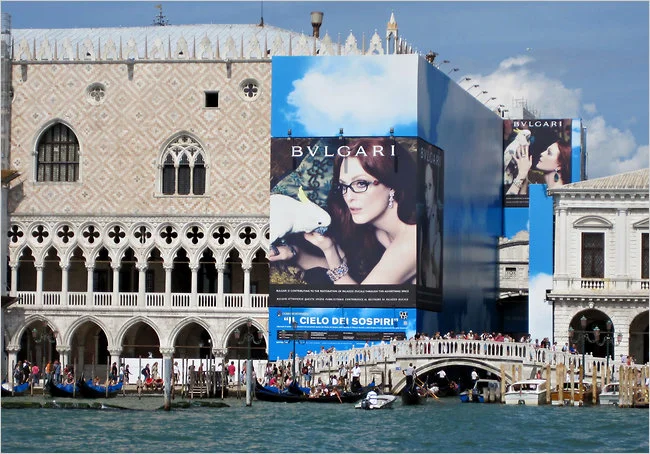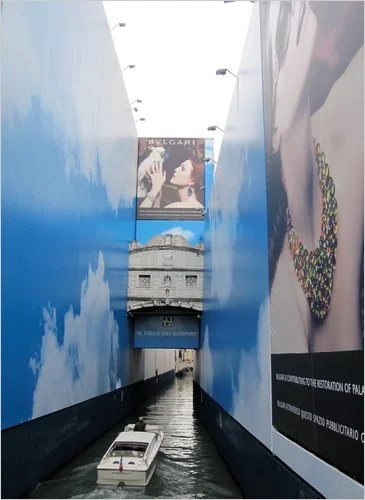Bulgari to Burgers | Italy Faces A Commercial Balancing Act
/Clearly I don’t understand the Italians as well as I thought. Perhaps I’m so jaded living in the depths of Smart Sensuality convictions that my good judgment about appropriate behavior has evaporated.
Having spent months of my life in Italy, living a wonderful love affair for five years with a well-known business executive, and having kissed the ground every time my plane landed on Italian soil, I was confounded to read that Julianne Moore’s Bulgari ad was deemed too sexy for Venice.
Personally, the ads were a bit disruptive to me — not for the discreet nakedness of Julianne Moore’s womanly body which has a long history of adulation in Italy, but for her cub friends. Making pets of wild animal babies is an unsettling message for AOC readers.
The New York Times visits the challenges of restoring Venice in a commercial world where corporate sponsorship of places and events involves not a quiet donation to preserving the planet but a typically visual announcement that can be seen for miles.
Here’s the officially-approved Bulgari ad that is inspiring Italian lovers, and I stand by my initial preference. Without the blue clouds outlining the image, the ad would blend so beautifully into the landscape, that it might belong there — as images of nude women have graced this country for thousands of years.
When the Coke billboards and vending machines went up around the Piazza San Marco this summer, impassioned Venetians exploded in anger.
“We couldn’t stay quiet,” said Maria Camilla Bianchini d’Alberigo, president of a heritage protection association. “Too much is too much.” Her organization, the Fondo Ambiente Italiano, denounced the intrusiveness of the ads, setting off the public debate. via NYT
Everyone agrees that the ads and sponsorship must exist. Italian government coffers can’t bail out the restoration of Venice, a fact of life we’ve known for years.
“Ads pay for the restoration of public buildings,” which would not get repaired otherwise, “even though many are a hazard for public safety,” said Renata Codello, the Culture Ministry official responsible for Venice’s monuments (told NYT).
Venice received under $2 million in 2010 for restorations.
Codello adds that billboards are much more prevalent in Rome and Italy.
Recalling that my first visit to Rome remains one of the five most wonderful days of my life, I can’t forget the horror I experienced on a followup trip, descending the Roman steps and finding a huge golden arches waiting for me.
My heart cried not so much over the hamburgers but the huge golden arches now complementing the bougainvillea that climbs the Spanish Steps.
A key question concerns not only the ad or brand sponsoring Venice but the degree to which it dominates the experience of Venice. Having drifted through the canals of Venice many times, I’m chilled over the pervasiveness of the sponsor’s message.
When ads dominate its landscape, the Venetian experience is destroyed. Imagine paying good money for this view of Venice. To be fair, perhaps this is the only such experience drifting in the canals of the city.
Italians remain terribly concerned that the appointment of Mario Resca, who ran McDonald’s Italian subsidiary for years to a new ministry post focused on developing museums signaled an intention to barter Italy’s historic patrimony for entrepreneurial commercialization.
Venetians like Marino Folin, president of the Venice Foundation, who supported the removal of a naked Julianne Moore, say that such Hollywood-style images are suitable for Las Vegas and Times Square but not Venice.
Restoring the Colosseum
Mario Resca’s first major project is the restoration of Rome’s Colosseum and he’s already operating under the watchful eye of Darius Arya, from the American Institute for Roman Culture, who knows the existing extent of commercialization of Rome’s classical beauty.
Tourists outside the colosseum in rome, italy. via The Washington post
In a contract made public on Aug. 4, 2010, the winner of the bid to restore the Colosseum will pay an estimated $33 million to refurbish the site, in return for exclusive advertising rights and associated perks linked to Rome’s biggest tourist attraction. The Colosseum draws more than 5 million visitors a year, producing 35 million euros in ticket sales used for other monuments in the city.
The sponsor will get to put its name and logo on tickets sold to the monument, and place posters no taller than 2.5 meters (8.2 feet) around the base of the structure. The sponsor also will be able to conduct private guided tours, and will have exclusive film rights of the restoration process, Giro said. via Bloomberg
The Colosseum won’t be billboarded, although Saatchi and Saatchi says that a logo could be projected into the sky.
“It is an iconic building,” says Agostino Toscan, from the advertising agency, “so it would have to be very subtle, as advertisers would not want to have their brand associated with anything vulgar.”
21st Century Italian Reality Check
Today we understand that the American/European, commercial/artistic collision of historic values and modern financial realities is tightly interwoven between our two continents. We can’t exist without each other, and as every article reviewed on this subject reminds us: the question is one of commercial vs aesthetic balance.
Business and branding are the only hope for salvaging the public Italian experience.
America’s approach to advertising is to dominate the subject’s consciousness. There are signs that Smart Sensuality values are signaling a quieter, more discrete approach for the luxury customer who most likely visits Venice.
With five million visitors to the Colosseum, Rome is more like Las Vegas, whether the Italians want to face the facts or dream on. Like the current Pope who wants to turn the altar away from the people and return to a Latin mass, many Italians are horrified at the degradation of the culture, led by Modern American values.
The hope of the Cultural Creatives, led by the more upscale Smart Sensuality women, is that we can all make peace with each other.
We Smart Sensuality types are the hybrid consumer, the women (and men) who understand the financial realities of global capital markets, but also embrace the international current value of Italy’s “la dolce vita’s” experience.
It’s irreplaceable, vital to our psychic and spiritual well-being, and a must-have for our journey into the future. There is significant brand-value capital in a lighter hand for advertisers who respect the landscape, forging a more sophisticated consumer relationship.
Traditionally, this is a European approach to commercialization, perhaps also Japanese but not Hong Kong or Shanghai. It will indeed be interesting to watch Italy’s maestro of golden arches balance the business of burgers and bougainvillea in the land that so inspires our sensual souls. Anne
36 Hours in Venice NYT 10-30-10



